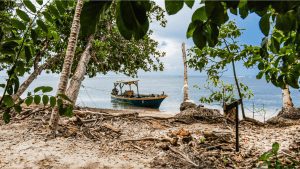[vc_row][vc_column width=”2/3″][vc_column_text]Looking to get away from almost all of it? The southern Caribbean region of Costa Rica just might be what you are seeking. This area is known for its beautiful beaches, friendly people and amazing Caribbean food.
One of Costa Rica’s seven provinces, Limón covers the entire Caribbean region, extending from the Nicaragua border to the Panamanian border. It is located in the country’s Caribbean lowlands. To the west is the mountain range Cordillera de Talamanca.
The Caribbean area is the most culturally diverse in the country. The majority of the people are Afro-Caribbean and indigenous populations. The traditional cultural food of this region is flavorful and uses wonderful spices and coconut. If you have ever been in Jamaica, the food has similarities.
 A couple of the best dishes in Costa Rica’s Caribbean are:
A couple of the best dishes in Costa Rica’s Caribbean are:
- Rondón: This coconut milk soup is the most well-known dish on the Caribbean Coast. Fresh fish, crab, yucca, plantain, yam, vegetables, and Caribbean spices make up this hearty medley.
- Pati: This baked empanada is filled with spicy ground meat. Habanero chiles, also known as chile panameno, provides a spicy kick. You can also buy them from roadside vendors as you drive towards Limón.
The charm of the Caribbean side of Costa Rica is in part due to its missing the major building boom experienced in regions like Guanacaste. It does not have the mega resorts and large sprawling communities. The remoteness of this province has also helped to keep it such a special place.
 Exquisite beaches
Exquisite beaches
The Caribbean has many of the most beautiful beaches in Costa Rica.
Palm tree-lined white sand beaches stretch for kilometers with very few people. The turquoise blue Caribbean waters team with colorful fish and coral. It is very inviting for snorkeling, sunbathing, surfing and swimming.
The weather on the Caribbean side is opposite from the west coast. This area has its own unique microclimate. The average year-round temperature is 87 Fahrenheit. The dry season runs from January to May and recurs in September and October. The rainy season is June through August, and then resumes during the wettest months of November and December.
Though Caribbean locations are not easy to access from San José, it is well worth the journey.
Here are a few places to visit and explore in this region.
- One of Costa Rica’s best kept secrets, Puerto Viejo, has only recently begun to gain recognition. For visitors seeking a less touristy alternative to the more crowded Pacific attractions, this fun little Caribbean surf town is fast becoming a popular destination. There is no doubt that this area is not for everyone, but it is perfect for a few. It has stunning beaches as well as many restaurants, bars and shops to enjoy between excursions and beach time.
- Tortuguero National Park is a popular destination for eco-tourists looking to spot wildlife and nesting sea turtles. The town lies between the lagoon and Playa Tortuguero. There are big waves, sharks, and dangerous riptides at the beach, which is unsuitable for swimming.
- Cahuita is a small fishing village located along the southern Caribbean coast. It is most popular for the national park, which safeguards coral reefs just off shore, and the rainforest. The peaceful town is fanned out, yet has an assortment of little gift shops and eateries. It is a colorful and wonderful place to visit.
- Between Puerto Viejo and Manzanillo on the southern Caribbean coast is where you’ll find Punta Uva. One of Costa Rica’s most picturesque beaches is also one of its least frequented. The spotless white sand beaches are ideal for swimming and are surrounded by beautiful palm trees. At specific seasons of the year, the reef in front of the beach is excellent for diving and snorkeling.
 Several of my friends have become fond of Costa Rica’s Caribbean and are making plans to buy a second Costa Rican home here because it is beautiful and peaceful. This might be a place to consider if the crowds are getting to you.
Several of my friends have become fond of Costa Rica’s Caribbean and are making plans to buy a second Costa Rican home here because it is beautiful and peaceful. This might be a place to consider if the crowds are getting to you.
It is worth a road trip to experience this region! Tell us about your trip to this region.[/vc_column_text][vc_empty_space][/vc_column][vc_column width=”1/3″][vc_btn title=”See this article in the digital magazine” color=”primary” link=”url:https%3A%2F%2Fissuu.com%2Fhowler%2Fdocs%2Fhowler_november_2022%2F64%3Ffr%3DsMzYzMDU0OTc4NTA|target:_blank”][vc_empty_space][vc_raw_html]JTNDaWZyYW1lJTIwc3JjJTNEJTIyaHR0cHMlM0ElMkYlMkZ3d3cuZ29vZ2xlLmNvbSUyRm1hcHMlMkZlbWJlZCUzRnBiJTNEJTIxMW0xOCUyMTFtMTIlMjExbTMlMjExZDE1NzMzLjMxMzMxMTY4ODU4JTIxMmQtODIuNzYxODIyOTgxNTI4ODIlMjEzZDkuNjUyOTYxNTkzNDE5NzMlMjEybTMlMjExZjAlMjEyZjAlMjEzZjAlMjEzbTIlMjExaTEwMjQlMjEyaTc2OCUyMTRmMTMuMSUyMTNtMyUyMTFtMiUyMTFzMHg4ZmE2NTAwY2ViOWVkZjE1JTI1M0EweDUzZWI4ZWFkYTI5NmI5NDUlMjEyc0xpbSUyNUMzJTI1QjNuJTI1MjBQcm92aW5jZSUyNTJDJTI1MjBQdWVydG8lMjUyMFZpZWpvJTI1MjBkZSUyNTIwVGFsYW1hbmNhJTIxNWUwJTIxM20yJTIxMXNlbiUyMTJzY3IlMjE0djE2NjY1NTQ5NjU1ODklMjE1bTIlMjExc2VuJTIxMnNjciUyMiUyMHdpZHRoJTNEJTIyNDAwJTIyJTIwaGVpZ2h0JTNEJTIyNDUwJTIyJTIwc3R5bGUlM0QlMjJib3JkZXIlM0EwJTNCJTIyJTIwYWxsb3dmdWxsc2NyZWVuJTNEJTIyJTIyJTIwbG9hZGluZyUzRCUyMmxhenklMjIlMjByZWZlcnJlcnBvbGljeSUzRCUyMm5vLXJlZmVycmVyLXdoZW4tZG93bmdyYWRlJTIyJTNFJTNDJTJGaWZyYW1lJTNF[/vc_raw_html][/vc_column][/vc_row][vc_row][vc_column][/vc_column][/vc_row]
